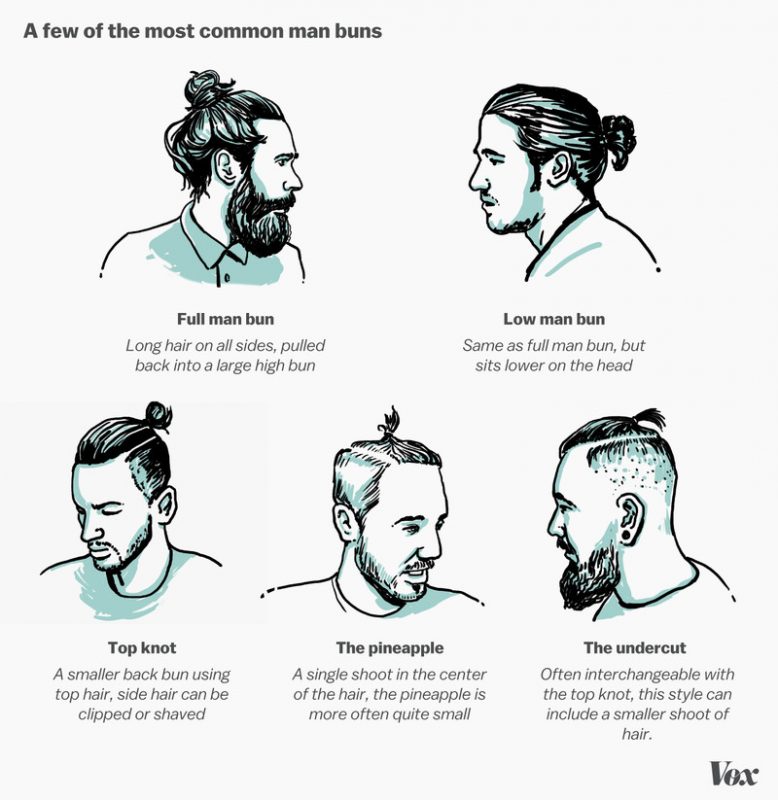The hipster man bun hairstyle rose in popularity late 2013, leading to an overabundance of how-to man bun videos and articles entering social media feeds and pages. This hot male hairstyle is comprised of an up-do that is tight in order for the knot of hair to rest securely on the top of the head. The trouble with this tendency, aesthetics aside, is that the practice of pulling hair into a bun exerts a pulling force on the root of the hair, which may result in traction alopecia if repeated over a sustained period of time. Loss due to tension-based alopecia begins at the regions of maximum pull, such as the hairline and edges, and develops over time. Hair loss due to this condition is permanent.

In the years following the popularity and daily wear of the hipster man bun, men have begun to see baldness and thinning near the borders of their hairline and temples. A frequent cause of hair thinning in men is male pattern baldness, characterized by its beginning stages in the recession of the temple and hairline points. But the man-bun manifestation of hair loss is brought on by the aforementioned condition, traction alopecia. This state of mechanically induced hair loss is usually seen in women. In order to cause it, an individual must have hair long enough to pull tightly in one direction for an extended amount of time. The tight hairstyle practiced by women, like weaves, cornrows, and ponytails, create tension that lead to tears on the hair follicles.
The Hipster Man Bun in Media
Changing gender norms have grown to embrace longer hair lengths in men, including the man bun and its relative, the half-knot, which makes men susceptible to the condition once regarded as a woman’s issue. The acceptance of this trend by mainstream media does not protect the man bun, however, from being the target of jokes as seen in the numerous man bun memes often shared around social media sites.

Medication for Damaged Hairline
Fortunately, men suffering from traction alopecia related to man buns do have treatment options. Typically, men discover topical medications like Minoxidil (Rogaine) early on in their hair loss recovery research. While widely used in the hair loss community as the leading hair treatment choice, these medications only work well for crown hair loss, which makes them ineffective for those losing hair around the hairline.
Do Natural, Home Remedies Work for Traction Alopecia Hair Loss?
Some herbal treatments for baldness operate on misconceived notions of what causes balding. For example, many articles online list home-remedies focus on the reparative effects of oil massages on the scalp with extracts of Indian Gooseberry, coriander, or aloe vera. These remedies are founded on the premise that poor blood circulation in the scalp causes hair loss. Although they might improve the texture of your hair, these scalp massages will not repair the hairline and borders damaged by extended time at a tight hair-style. The damage caused by follicles being torn from their structures cannot be repaired by any improvement of blood circulation.
Young male adults who identify with the hipster subculture are likely to show an interest in natural remedies. They may find research supporting the use of green tea and ginseng for hair loss due to compounds like EGCG, known to block DHT, a main factor in hereditary hair loss. However, there are no known cases where these remedies have actually reversed hair loss. Plus, when it comes to traction alopecia, DHT is not the main factor in hair loss which results.
A Cure for Hipster Man bun Induced Traction Alopecia
A hair transplant surgery is the only cure for men facing hair loss due to traction alopecia. There are two main methods practiced by hair transplant surgeons today: a follicular unit transplant (FUT) or a follicular unit extraction (FUE). An FUT operation involves a surgical incision at the back of the head, where a flap of hair-bearing skin is removed and harvested for follicles. This procedure tends to leave its mark in the shape of a scar on the back of the scalp. Depending on an individual’s skin laxity, this scar could stretch into an even bigger, obvious shape. In a FUE hair surgery, hair roots are extracted by way of a rotary punch instrument, which separates the surrounding tissue from the follicle. This procedure, while less invasive, still leaves behind raised circular scars on the scalp.
It is important to note well that both of these treatments for traction alopecia hair loss use the back of the head for the donor supply of follicles. This means that the thicker follicles from the back of the head are transplanted to the front, often resulting in a hairline that looks mismatched or overtly artificial. For men who aim for a hairline as close to their original one as possible, this result can be unacceptable.
The advanced FUE Dr.UGraft system offers an alternative solution for men focused on the final result of these hairline restoration. Composed in part by an innovation on the basic FUE punch, the Dr.UPunch Rotor tool allows for hair to be extracted from all over the body with a high success rate. Because of its unique design, the hybrid punch helps follicles avoid common causes of death such as exposure to air, or damage from using surgical instruments. Men looking to restore their damaged hairline benefit in several different ways, including: significantly more options for their own donor hair site, a greater number of grafts available, a better chance of seeing growth after operation, and needless to say, a softer, natural looking hairline.
A transplant using the UGraft system guarantees men a greater likelihood of being able to style their own hair in the hottest fashion by providing them with more workable grafts. Other transplant surgeries are prone to graft failure, but the Dr.UGraft system offers men reliable growth 12-18 months after surgery. This means men can resume styling their hair into unique looks like the man bun, albeit with the added foresight to use less force.

